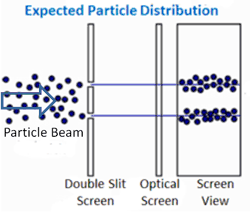Young's Double-Slit Interference Experiment
Extended to Show Behaviour of Particles
In 1801 Thomas Young devised the Double-Slit experiment to demonstrate the wave nature of light. Over 100 years later, in 1909 G. I. Taylor used a similar set up to demonstrate the corpuscular nature of light. Taylor used a beam of photons from a very low light source in his investigations. Since then, Taylor's experiments have been repeated with electrons and larger matter particles with similar results confirming the quantum properties of other matter particles.

| Young's Original Experiment A coherent light wave was separated into two overlapping wavelets emamating from the slits creating an interference pattern as the amplitudes of the wavelets are combined producing light and dark fringes on the optical screen. The blue lines connecting the crossing points of the wavelet peaks indicate where increased amplitude of the combined wave occurs. Known as constructive interference, the resulting light wave leads to the light fringes on the screen. Destructive interference occurs progressively between the blue lines to a maximum when the crest of one wavelet coincides with the trough of the other wavelet resulting in zero amplitude of the wave and hence the dark fringes. |
 |
Classical Physics Theory It was predicted that the particle nature of light would produce results different from Young's. A beam of individual photons directed at the slits was expected to be separated by the slits into two parallel photon beams. These beams would pass undeflected through the two slits creating two light fringes on the screen. This however did not happen. |

Images Public Domain: by Inductiveload, Modified |
Quantum Physics Results Surprisingly, Taylor's experiment with photons produced a series of interference fringes similar to those produced by Young's waves. Mysteriously, the brightest fringe did not appear directly behind either of the slits but in a position exactly half way between the two, behind the obscuring optical screen. A new theory was therefore required to explain quantum physics. This was provided by Bohr, Heisenberg and others who developed the Copenhagen Interpretation |
Taylor's experiment showed that single quantum entities (such as photons and electrons) appeared to travel simultaneously through both slits, reforming on the other side. Another explanation for this is that the particles seem to travel like waves but arrive as particles.